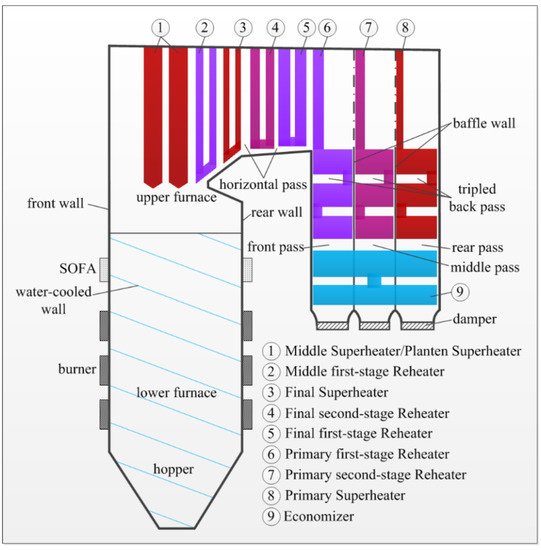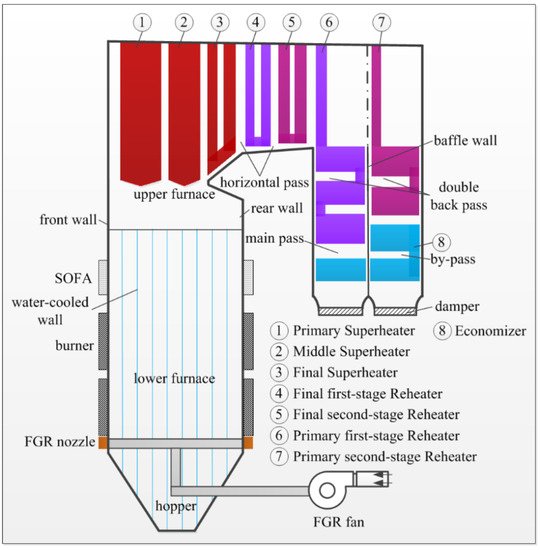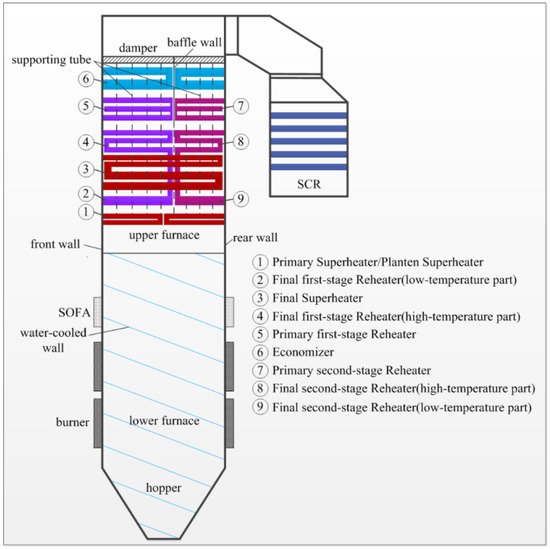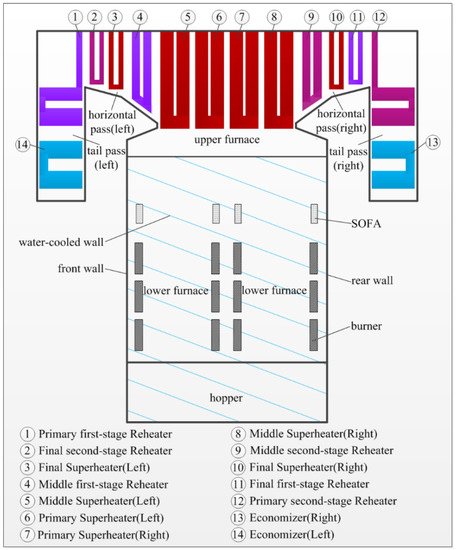The ultra-supercritical (USC) double-reheat technology is an immediate area of research focus in China, since the thermal efficiency of USC double-reheat unit is higher than the USC single-reheat unit. The parameters and capacity of USC double-reheat unit in China have made major breakthroughs, and the thermal efficiency of the units are as high as 47–48%, which is the highest in the world. USC double-reheat boiler is one of the most important devices for USC double-reheat unit, and the design concept and precision have a vital effect on the operation of boiler and power station. The most difficult and important factors in the design of double-reheat boiler are the layout of heating surface and the steam temperature regulation method.
1. Introduction
Coal is the primary energy source and plays a dominant role in thermal power generation in China. Pulverized coal fired power plants consume 50% of the coal in China and contribute nearly 50%, 35%, and 35% of the total SOx, NOx, and dust emissions, respectively [
1]. The emissions of CO
2, which is a greenhouse gas, are another serious environmental problem caused by coal combustion. These pollution problems are harmful to both human health and the development of society [
2,
3].
It is generally understood that the improvement in thermal efficiency is bound with low coal consumption and low pollution emissions as well as low CO
2 emissions [
4,
5]. Especially, CO
2 emissions decrease almost linearly with the increase of net plant efficiency [
6], which confirms the feasibility of reducing CO
2 emissions by improving the net plant efficiency [
4,
7]. Based on the above cognition, the development of high-parameter and large-capacity ultra-supercritical (USC) units with high efficiency for reducing pollutant emissions is greatly promoted in the world.
Since the 1990s, different countries have conducted high-temperature, high-pressure, and large-capacity USC coal-fired units. The parameters of the units are developed from subcritical, supercritical, and ultra-supercritical characteristics and have improved the power generation efficiency from 35% to 43% [
4]. Especially, the USC units of 35 MPa/700 °C with thermal efficiency exceeding 50% are currently considered to be the most advanced and efficient power generation facilities. As one of the 35 MPa/700 °C USC units, AD700 cycle has been operated since 1998 in Europe [
8]. Besides, the United States, Japan, and China have also planned to develop 700 °C USC power generation technology. However, the promotion of this unit needs to overcome the difficulties in terms of strength of metal material at 35 MPa/700 °C, resistance of corrosion at high temperature, and the service life of the metal material [
8]. Actually, the 700 °C metal material is too expensive to be used on a large scale, which greatly limits the development of USC units. Until now, there is no such unit operating in the world [
9].
The USC double-reheat unit is a result of USC units proposed between the USC single-reheat unit and the future 35 MPa/700 °C unit. Furthermore, the double-reheat unit can improve the average heat absorption temperature of the Rankine cycle [
10]. In addition, it can reduce the exhaust humidity in low pressure cylinder, which is beneficial for the safe operation of steam turbine. Compared with the USC single-reheat unit, the USC double-reheat unit has improved thermal efficiency (by 1.0%) [
6]. Generally, the thermal efficiency of double-reheat unit with the parameters of 30.0 MPa/600/620/620 °C is about 2% higher than the traditional single-reheat unit having the parameters of 24.1 MPa/566/566 °C. Moreover, there is no significant technical bottleneck, and the existing materials can meet the requirements of USC double-reheat unit production with the parameters of 30.0 MPa/600/620/620 °C. Therefore, China has identified the USC double-reheat unit as the key point of future research for the high-parameter power generation unit, because the energy efficiency and environmental protection become more and more important with the development of economy. Therefore, a great number of studies have been conducted on clean and efficient coal combustion and power generation, in which the double-reheat technology was the main focus.
The double-reheat boiler is one of the most important devices in double-reheat units, and it consists of technological integration of steam temperature regulation, combustion organization, heating surface arrangement, and pollution control of USC single-reheat boiler. However, it is more complicated than the single-reheat boiler [
11]. Firstly, it is difficult to design and arrange the heating surface in furnace since there are two stages of reheat heating surfaces in the double-reheat boiler. Secondary, the mass flow rate of the main steam of double-reheat boiler decreased compared to that of the singe-reheat boiler. Thirdly, the water-vapor flow circuitry is complicated and the dynamic response characteristics of boiler change significantly. Therefore, the temperature regulation methods of main steam and reheat steam changes. Finally, the steam pressure and tube metal temperature nearly reach the material limitation. The metal temperature of the heating surface should be precisely controlled.
2. Brief History of Double-Reheat Boiler
The double-reheat boiler has been investigated in the United States, Europe, and Japan from the 1970s to the 1990s, and the parameters of most boilers are around 560 °C and 24 MPa [
18,
19]. The companies in these countries have carried out research on double-reheat technology and have obtained a variety of experimental and practical operational data. As a typical representative, among the operating double-reheat units in the world in 1998, the Nordjyilands Vaerker power plant in Denmark operating with a 400 MW and 29.0 MPa/580/580/580 °C double-reheat boiler had the highest thermal efficiency of 47% [
18,
19].
However, in the last two decades, no new double-reheat unit was built due to low electricity demand and adjustment of energy structure in these countries. In contrast, the USC double-reheat unit has attracted a lot of attention in China in recent years [
20].
In China’s 10th Five-Year Plan, the USC double-reheat power generation technology was identified as a focus project [
21]. During the 12th Five-Year period [
22], three power plants were approved by National Energy Administration to construct USC double-reheat units. Additionally, it is also the key technology for the “action plan for retrofitting and upgrading of energy conservation and emission reduction for thermal power plants (2014–2020)” [
23]. Based on these plans, universities, electric power design institutes, and the major power device manufacturers in China have carried out a lot of research on the double-reheat boiler and have made remarkable progress.
Many power generation projects involving double-reheat technology have been approved in China. Especially, the three power plants approved in the 12th Five-Year Plan have already been finished and their commercial application shows the development prospects of this technology in China. The double-reheat boilers in China are equipped with the capacities of 1000 MW and 660 MW, with steam pressure over 30 MPa and temperatures over 600 °C. The design efficiency for power generation is as high as 47–48% [
24], which is the highest level worldwide. The design and operational experience of double-reheat units with high parameters and high capacity in China will provide a useful reference for the development of this technology.
3. Scheme for Heating Surface Arrangement
Considering the different absorption characteristics of superheated steam and two stages reheated steam, the superheat and reheat exchanger systems are well designed and arranged to ensure that the heat absorption ratio of each section of the heating surface is reasonably distributed. Until now, there have been three types of double-reheat boilers in China, and they are the inverse U-type, tower-type, and T-type double-reheat boilers.
3.1. Inverse U-Type Double-Reheat Boiler
Presently, there are two kinds of inverse U-type double-reheat boilers operating in China. One is triple back passes and the other is double back passes.
3.1.1. Inverse U-Type with Triple Back Passes
The inverse U-type double-reheat boiler with triple back passes adopts a wall-fired combustion system, single furnace with spiral-wound and vertical pipe combined water-cooled wall, and three parallel vertical back passes split by the baffle wall in the back pass [
25]. The sketch of this boiler is shown in
Figure 1, and it operates at 32.6 MPa/605/623/623 °C. As can be seen, the superheater and the first-stage reheater are divided into three sections, and the second-stage reheater is divided into two sections. In this work, the heating surface which is divided into three sections are respectively named as primary, middle, and final, and the heating surface which is divided into two sections are respectively named as primary and final.
Figure 1. Wall-fired double-reheat inverse U-type boiler with triple back passes.
Obviously, the most significant feature of the boiler is the triple back passes. In addition, the superheater adopts a convective & radiant & semi-radiant heat exchanger system. This means the primary superheater absorbs energy by convection, the middle superheater absorbs energy from high temperature flue gas by radiation, and the final superheater absorbs energy primarily by convection and secondarily by radiation. While the first-stage reheater uses the convective & semi-radiant & convective heat exchanger system. Additionally, the second-stage reheater employs a convective & convective heat exchanger system. It is inappropriate to dispose the reheater in the high flue gas temperature zone because the steam pressure in the two stage reheaters both are lower than that in the superheater, which means a lower steam density and lower heat transfer coefficient. Moreover, the second-stage reheater was disposed as convective heat exchangers only in the lower flue gas temperature zone, since the steam pressure in the second-stage reheater is lower than that in the first-stage reheater.
3.1.2. Inverse U-Type with Double Back Passes
The U-type double back passes boiler consists of a single furnace, a wall-fired combustion system, with spiral-wound water-cooled wall in the lower furnace and vertical water-cooled wall in the upper furnace. The schematic of the boiler is shown in
Figure 2 [
25], and it operates at 32.6 MPa/605/623/623 °C. The back pass is split into two parallel vertical back passes using the baffle wall, which are respectively known as the main pass and by-pass.
Figure 2. Wall-fired double-reheat inverse U-type boiler with double back passes.
The superheater is divided into three sections, while both the first-stage reheater and second-stage reheater are divided into two sections. The superheater adopts the radiant & semi-radiant & semi-radiant exchanger system, while the two stage reheaters are pure convective heating surfaces. Therefore, the steam temperature of the two stage reheaters is sensitive to the flow rate of flue gas, and the distribution of heat absorption between the superheated steam and reheated steam can be adjusted using flue gas recirculation (FGR).
The characteristics of this scheme are as follows. Firstly, the final first-stage reheater and final second-stage reheater are arranged in the horizontal pass to ensure the safety of the reheater, where the flue gas temperature is relatively low. Secondly, the steam temperature is sensitive to FGR since both of the two stage reheaters are arranged as convective heat exchangers.
Figure 3 shows another inverse U-type double-reheat boiler with doubled back passes, and the rated parameters are the same as the boiler shown in
Figure 2. Compared with the boiler shown in
Figure 2, this boiler adopts the tangentially-fired combustion system and vertical membrane water-cooled wall. Furthermore, the superheater adopts radiant & radiant & semi-radiant heat exchanger system [
26]. Both of the two stage reheaters employ the convective & convective heat exchanger system, which is the same as the doubled back passes boiler introduced earlier. Therefore, the steam temperatures of the two stage reheaters are also sensitive to FGR.
Figure 3. Tangentially-fired double-reheat inverse U-type boiler with double back passes.
In short, for the inverse U-type double-reheat boiler, in order to ensure the heat absorption and safe operation of superheaters, a primary or middle superheater should be arranged in the upper furnace with high flue gas temperature. The reason is that the temperature of the working fluid and tube metal of primary and middle superheaters is relatively low. The final superheater should be arranged in the zone with middle flue gas temperature to prevent the overheating of the final superheater tube. The final sections of the first-stage reheater and second-stage reheater are also arranged in the middle flue gas temperature zone to prevent the overheating of reheater tube. Furthermore, the primary sections of the first-stage reheater and second-stage reheater are generally arranged in the back passes of the boiler.
3.2. Tower-Type Double-Reheat Boiler
Different from the two kinds of inverse U-type double-reheat boilers, the tower-type layout with tangentially-fired double-reheat boiler is also widely adopted in China. Generally, the superheater, reheater, and economizer heat exchanger systems of the tower-type boiler are all horizontally arranged in the upper furnace. The flue gas flows over them and then turns downward to the outlet of the boiler. Therefore, the tower-type boiler is obviously higher than the inverse U-type boiler, and the layout characteristics of heating surfaces are different from the inverse U-type boiler.
Considering the characteristics of the double-reheat boiler, the superheater and two stage reheaters of tower-type double-reheat boiler are all divided into two sections, as shown in
Figure 4 [
27,
28], and they operate at 32.6 MPa/605/623/623 °C. In addition, the final first-stage reheater and final second-stage reheater are divided into two parts, namely the low-temperature part and high-temperature part, respectively. The final superheater is arranged between the two parts of the two reheaters. This layout is called the combined heating surface, and this layout was adopted in some 1000 MW and 660 MW double-reheat boilers.
Figure 4. Schematic of the double-reheat tower-type boiler with combined heating surface.
As can be seen from Figure 4, the main feature of the heating surface layout of this boiler is that the final superheater and final section of the two reheaters are combined together. Specifically, the low-temperature part of the two reheaters is arranged near the combustion zone between the platen superheater and final superheater, and the high-temperature parts of the two reheaters are arranged in the downstream of the final superheater. Obviously, the low-temperature parts of final first-stage reheater and final second-stage reheater are designed as radiative absorption heating surface and arranged near the high temperature zone; this arrangement improves the radiation absorption ability and ensures the heating surfaces are sensitive to the position of fireball in the furnace. Meanwhile, the corresponding high-temperature parts of the two reheaters are designed as convective absorption heating surfaces and arranged at the middle temperature zone. With this scheme, the heating surface is much safer, more economical, and reliable, although the outlet steam temperatures of the final first-stage reheater and final second-stage reheater are high.
Figure 5 shows another heating surface layout of tower-type double-reheat boiler [
29,
30], and it also operates at 32.6 MPa/605/623/623 °C. As can be seen, the superheater is divided into three sections, and both the two stage reheaters are arranged as two sections. Both the primary and final superheaters are disposed in the upper furnace upstream the furnace exit, while the final first-stage reheater, final second-stage reheater, and the middle superheater are subsequently disposed downstream the furnace exit. Then, the flue gas is divided into two ways to meet the primary first-stage reheater and primary second-stage reheater and the economizer. Obviously, the arrangements of the heating surfaces are different from the layout characteristics of tower-type double-reheat boiler reported earlier. However, it was found that when the later tower-type double-boiler was put into commercial operation, especially under low load, the superheater of the boiler was over-heated, and the temperatures of steams in the two stage reheaters made it difficult to reach the rated value [
30]. The reason for this may be that the primary and final superheater both are arranged just downstream of the furnace exit, and lots of heat was absorbed by the two heating surfaces.
Figure 5. Schematic of the double-reheat tower-type boiler without combined heating surface.
In order to solve this problem, a new concept of combined heating surface layout design was proposed, which is similar to the arrangement of the former tower-type double-reheat boiler. However, its heating surface arrangement is comparatively far away from that of the former. The detailed combined heating surface of the new boiler is shown in Figure 6. It is obvious that the final first-stage reheater is divided into two parts, namely the low-temperature part and high-temperature part. Additionally, the second-stage reheater is arranged between the low-temperature part and high-temperature part of the final first-stage reheater. The specific effect will be obtained once the unit is commercially operated.
Figure 6. Another schematic of the double-reheat tower-type boiler with combined heating surface.
3.3. T-Type Boiler
The T-type layout was also adopted in the double-reheat boiler.
Figure 7 shows the layout details of the heating surface, which is significantly different from the inverse U-type boiler and tower-type boiler [
25]. The T-type boiler is a single furnace and double-chamber wall-tangentially-fired boiler, with the spiral-wound water-cooled wall in the lower furnace and vertical tube water-cooled wall in the upper furnace. The back pass is divided into two portions arranged symmetrically on both sides of the furnace. The superheater, first-stage reheater, and second-stage reheater are all divided into three sections, which are disposed symmetrically on the left and right sides of the boiler. The primary superheater and middle superheater are arranged symmetrically on the upper furnace, while the primary first-stage reheater, primary second-stage reheater, middle first-stage reheater, and middle second-stage reheater are arranged symmetrically. However, the final first-stage reheater and final second-stage reheater are in a cross arrangement.
Figure 7 indicates that the superheater adopts a radiant & radiant & convective exchanger system, and both the two stage reheaters adopt the convective & semi-radiant & convective exchanger system. With this arrangement, the heat absorption of the superheater and the resistance of flue gases can be balanced on both the sides. In addition, as the back passes are arranged symmetrically on both sides of the furnace, the height of the furnace exit window can be reduced. The flue gas flow in the horizontal pass can be improved and the thermal maldistribution of the flue gas across the window height can be mitigated.
Figure 7. Schematic of the T-type double-reheat boiler.
This entry is adapted from the peer-reviewed paper 10.3390/pr9122197







